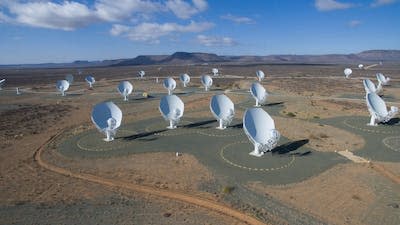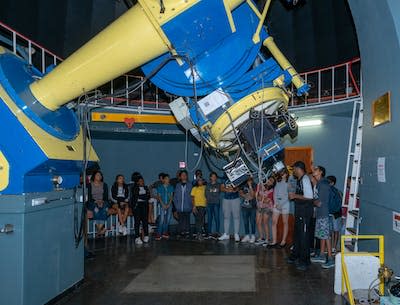South African astronomy began an important journey two decades ago, when an initiative to attract and train future scientists in the field welcomed its first group of students under the National Astrophysics and Space Programme.
State-of-the-art facilities were established during this period, the most notable being the Southern African Large Telescope (SALT) and the MeerKAT radio telescope, a precursor to the international Square Kilometer Array. They add to the existing South African Astronomical Observatory and Hartebeesthoek Radio Observatory.
The National Astrophysics and Space Science Program played a critical role in ensuring that these facilities were not simply operated for the benefit of international partners. It has also helped equip individuals with critical data analysis skills for the country’s growing high-tech workforce.
As astronomers who have been part of this journey – organizers, contributors and beneficiaries – we are using the 20th anniversary date to reflect on the impact of the program and its importance to the country.
The history
South Africa’s astronomical history, spanning more than 200 years, took a leap forward in 2000 with cabinet approval for the construction of the Large South African Telescope.
Beyond its scientific impact, the idea was to attract and nurture young talent, addressing a shortage in the fields of science and engineering in South Africa.

At the time, there were only about 40 astronomers with PhDs in the country. All were white. This was a result of the racially skewed education system during the apartheid era.
In 2001, astronomers began preparing for SALT and future projects. The Square Kilometer Array (SKA) emerged as an opportunity to host a large international radio telescope that could, among other things, probe the beginning of the Universe. Unfortunately the shortage of astronomers from South Africa threatened the success of both projects, and African participation.
Read more: How visionary scientist Bernie Fanaroff put African astronomy on the map
Develop a pipeline
Becoming a professional astronomer requires a PhD in astronomy, physics, or a related subject. It takes about 10 years to qualify after completing secondary school. At that time less than 1% of black school leavers qualified to study for a BSc in physics or astronomy.
It was clear that universities had to start collaborating if the landscape was to change. The country’s small astronomical community was spread over eight universities and two national facilities.
A decision was taken to pool resources to establish the National Astrophysics and Space Science Program. In this way, university lecturers and professionals at the national observatories could supplement the teaching, and students could choose from a wide range of research projects.
This collaboration, which included the organization that became the South African National Space Agency, focused on guiding students through honors and master’s degrees. It emphasized collaboration over institutional interests and targeted young scientists, particularly those from previously disadvantaged communities.
The main objectives were clear:
-
attract post-Bachelor of Science students
-
recruiting from other African countries
-
attract school leavers into BSc physics programmes
-
making participation in the program a selling point for all participating universities.
Bursaries covering basic needs were crucial in attracting bright students from disadvantaged backgrounds. Funding from private foundations, notably the Ford Foundation, the Mellon Foundation and the Canon Collins Trust, supplemented basic grants from the National Research Foundation.
Today, the government’s Department of Science and Innovation is the main funder.
Grants are sufficient, rather than generous. However, students have developed successful careers through the program, revolutionizing astronomy and space science in South Africa and beyond.
Program participant Pfesesani van Zyl said:
The trip to SALT was a truly transformative experience for me … As a child growing up in a small town, a career in astronomy seemed like an unattainable dream, especially as a female of color … However, that visit into those restrictions. religious.
As former beneficiary Roger Deane, now a professor at the University of the Witwatersrand, said, the program was central to
Record track
By mid-2023, the National Astrophysics and Space Science Program had produced 439 honors graduates and 215 master’s degrees in astrophysics and space science. 27 honors students and 21 master’s students are due to graduate soon, and a similar number of students will complete their degrees in 2024.
A 2023 survey of program graduates had 230 respondents, including 53 graduates from 19 other African countries. The largest number came from Uganda, Madagascar, Ethiopia, Kenya, Zambia and Sudan. Many have returned home.
Former participant Miriam Nyamai said:
Collaborating with international researchers through the program enabled me to conduct excellent research, attend international conferences, and give talks on my work.
Influence
The impact of the program’s graduates goes far beyond academia. Many have gone on to successful careers across a variety of sectors, including industry, education and government.
Graduates participated in exciting astronomical discoveries. These include producing the first images of black holes with the Event Horizon Telescope, discovering some of the most distant galaxies yet known, and using SALT to detect the remnants of some very massive binary stars and unusual active black holes to investigate.
The work of many individuals has been recognized by national and international bodies and program graduates are in key teaching and research positions in South African universities. There are over 30 employees in the national astronomy facilities and the national space agency, some of whom have prestigious positions in other parts of the world. South Africa now has over 200 qualified astronomers, not including the National Astrophysics and Space Science Programme.
However, filling astrologer vacancies in South Africa remains a challenge. Many factors contribute to this, including funding, opportunities outside of academia, and a lack of clear career paths. The National Astrophysics and Space Science Program cannot be part of the solution to these complex systemic problems.
Directions for the future


The program has developed since its inception. Students now have to navigate vast amounts of complex data of different types, from different sources. Machine learning and artificial intelligence are indispensable. Students need to know what these tools can and cannot do as they push the boundaries of our understanding. This is a challenge for both students and their mentors.
The main challenge now, as it did 20 years ago, is to help university staff collaborate across institutions so that their work is recognized and rewarded. This requires senior administrators to understand that inter-university collaborations are an investment in their own institutions and in the advancement of South African science.
To commemorate the 20th anniversary of the National Astrophysics and Space Science Programme, a two-day symposium was organized in January 2024, hosted by the University of Cape Town in South Africa.
This article is republished from The Conversation, a non-profit, independent news organization that brings you reliable facts and analysis to help you make sense of our complex world. Written by: Patricia Ann Whitelock, South African Astronomical Observatory; Daniel Cunnama, South African Astronomical Observatoryand Rosalind Skelton, National Research Foundation
Read more:
Patricia Ann Whitelock receives research funding from the National Research Foundation and the University of Cape Town.
Daniel Cunnama receives funding from the National Research Foundation. He works with the South African Astronomical Observatory, a business unit of the National Research Foundation.
Rosalind Skelton receives funding from the National Research Foundation. She works with the South African Astronomical Observatory, a business unit of the National Research Foundation.